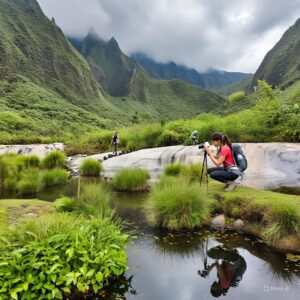
As eco-tourism evolves in the digital age, Kerala’s Silent Valley Biosphere Reserve stands out as a pioneering example of how technology can enhance sustainable travel. Known for its untouched biodiversity and rich forest ecosystem, Silent Valley is now integrating innovations like AR-guided trails, drone surveillance, and smart visitor systems to enrich the tourist experience while preserving its fragile environment. This tech-powered transformation is positioning Silent Valley not just as a nature haven but as a model for future-ready, responsible tourism in India.
Why Silent Valley Is So Unique
Before delving into the tech aspect, it’s important to understand why Silent Valley National Park holds such a revered place among conservationists. Spanning over 237.52 square kilometers in the Palakkad district of Kerala, Silent Valley is part of the Nilgiri Biosphere Reserve and a UNESCO-recognized biodiversity hotspot.
Home to endangered species like the Lion-tailed Macaque, Nilgiri Langur, and Malabar Giant Squirrel, it also harbors thousands of plant species, including many endemic to the region. The absence of large-scale human interference has made it a living laboratory for researchers and a paradise for eco-conscious travelers.
The Rise of Tech-Powered Eco-Tourism in Kerala
As global travelers increasingly prioritize sustainable tourism, Kerala has taken significant steps to blend conservation with innovation. The Kerala Tourism Department and environmental agencies have started implementing smart technologies across eco-sensitive zones, including Silent Valley.
Some of the top eco-tourism technologies used include:
-
GPS-based trekking guides
-
QR-coded trail markers
-
Augmented reality (AR) mobile apps
-
Eco-surveillance using drones
-
Digital visitor management systems
This shift not only enhances visitor experience but also aids in real-time conservation monitoring, ensuring that tourism remains aligned with ecological goals.
Smart Trekking Trails and Guided Walks
One of the most impactful uses of technology in Silent Valley is the integration of GPS-enabled trekking apps. Tourists can now navigate trails using mobile applications that offer offline maps, voice-guided paths, and safety alerts. This reduces dependence on printed materials and ensures that visitors stay on designated routes, helping prevent disturbance to sensitive areas.
Moreover, some eco-tour operators are using AR headsets and apps that overlay information about flora, fauna, and terrain as you walk, offering a digitally immersive yet nature-respectful experience. It’s eco-education in real time.
Eco-Monitoring with Drones and Sensors
Another tech-driven innovation is the use of drone technology and environmental sensors to monitor the forest’s health. These devices collect data on air quality, canopy density, and wildlife movements without physical intrusion. Forest officials use this information to:
-
Track animal behavior patterns
-
Identify illegal activity (like poaching or deforestation)
-
Monitor visitor flow in real time
This helps maintain ecological balance while supporting sustainable tourism practices.
Visitor Experience Through QR Codes and AR
Interpretive signs along Silent Valley trails now often include QR codes. By scanning them, tourists can access multilingual content about specific species, cultural significance, and conservation facts. This reduces the need for physical signage and keeps the park visually natural.
Additionally, AR-based apps allow visitors to visualize rare animals or extinct species in their original habitats, making the experience both educational and awe-inspiring, especially for younger audiences and school groups.
Digital Booking and Eco-Pass Systems
In a bid to minimize over-tourism and control carbon footprints, Silent Valley now uses an online eco-pass system. Travelers must pre-book their slots via digital portals, ensuring that visitor numbers remain within permissible limits. These systems also generate digital receipts and park guides, promoting a paperless, low-waste tourism model.
Furthermore, AI-based visitor analytics are helping forest departments understand peak timings and suggest alternative time slots, thus evenly distributing footfall and reducing stress on the ecosystem.
Empowering Local Communities with Green Tech
Eco-tourism in Silent Valley is not just about the visitors; it also empowers local communities. Tech-enabled tourism has opened up new employment opportunities for tribal and rural populations. Locals are trained as digital eco-guides, drone operators, and app facilitators.
Workshops on green energy, sustainable hospitality, and digital storytelling are allowing communities to protect their culture while participating in the tourism economy. This inclusive development model aligns with Kerala’s larger goal of tech-driven sustainability.
Challenges in Balancing Tech and Ecology
While technology enhances eco-tourism, it’s essential to recognize the risks of over-digitization. Gadgets and screens should not replace the raw experience of the forest. There’s a fine line between enriching tourism and disrupting nature.
To address this, Kerala’s forest department adheres to strict guidelines:
-
No mobile towers are allowed inside the core zones.
-
All tech equipment must be solar-powered or low-impact.
-
Noise pollution from drones or gadgets is strictly monitored.
-
Human access to core biodiversity zones remains restricted.
These practices ensure that Silent Valley remains silent, as nature intended.
Looking Ahead: The Future of Smart Eco-Tourism in Silent Valley
The Digital Science Park in Trivandrum, a first-of-its-kind initiative in India, is expected to further boost eco-tourism innovations. Startups focusing on green technology, conservation AI, and immersive tourism will find opportunities to collaborate with environmental agencies.
As Kerala continues to evolve into a tech-savvy eco-tourism leader, Silent Valley could become a global example of how technology and ecology can co-exist. It offers a blueprint for the world: preserve, educate, innovate—all without harming the natural rhythm of the forest.
Conclusion
Exploring Silent Valley is no longer just about admiring nature—it’s about understanding it, protecting it, and innovating with purpose. Through smart tourism initiatives, digital tools, and community-driven sustainability, Kerala is redefining what it means to be an eco-traveler in the 21st century.
If you’re planning a visit, let Silent Valley be more than a destination—let it be an interactive, conscious journey powered by technology and driven by nature.

Leave a Reply